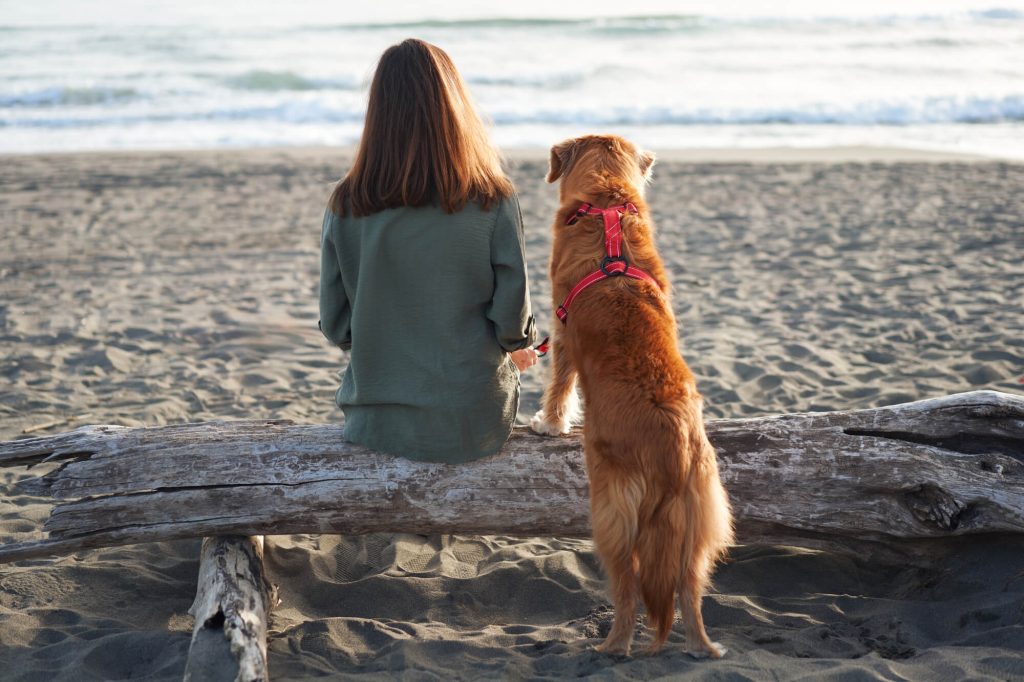
When a dog has mobility issues that are caused by conditions like arthritis, IVDD, or something else, harnesses can serve as a useful tool to support them in ways a traditional collar can not. As dogs age or encounter health setbacks, their need for physical support increases. A well-fitted harness can make a significant difference, offering them a new lease on life by enabling safer, more comfortable movement.
Arthritis in dogs is a condition that leads to inflammation and degeneration of joints, causing pain, stiffness, and a decrease in mobility. It’s similar to what humans experience, but our furry friends can’t exactly tell us when they’re hurting.
As dogs age, the wear and tear on their joints can lead to this painful condition, making everyday activities like walking, jumping, and even getting up from a resting position challenging. Symptoms include:
It’s a tough situation, both for the dog experiencing discomfort and the owner watching their beloved pet struggle.
Unlike traditional collars, which can put unnecessary pressure on the neck and joints, a well-designed harness distributes weight and pressure more evenly across the body. This can significantly reduce the strain on arthritic joints, making it easier and less painful for dogs to move around.
Plus, some harnesses come equipped with handles or support straps, giving owners the ability to gently assist their dogs when they need a little extra help getting up, climbing stairs, or getting into a car. CBD for Pets can also provide relief from the discomforts caused by arthritis in dogs. It has anti-inflammatory properties which can reduce the inflammation of joints caused by arthritis, thereby decreasing your dog’s discomfort.
A well designed harness in combination with CBD for Pets can restore a sense of freedom and joy to your dog’s daily walks and playtime, despite the challenges of arthritis.
Intervertebral Disc Disease (IVDD) is a serious condition that affects the spine of dogs, leading to pain, nerve damage, and in severe cases, paralysis. The disease occurs when discs between the vertebrae of the spine either bulge or burst (herniate) into the spinal cord space, causing inflammation and discomfort.
This can happen due to degeneration over time or because of genetic predisposition in certain breeds. Dogs with IVDD may show signs of severe pain, unwillingness to jump or move, and can even lose control over their limbs. It’s a condition that requires immediate attention to manage symptoms and improve quality of life.
For dogs suffering from IVDD, a harness can be a crucial aid in managing their mobility and comfort. Traditional collars can exacerbate pain and discomfort by putting pressure on the neck and spine during walks. In contrast, a well-fitted harness distributes the pressure away from the spine and neck, helping to prevent additional stress on these sensitive areas.
Moreover, harnesses designed specifically for dogs with IVDD often include features like handles or support straps, allowing owners to gently assist their dogs when walking, climbing stairs, or getting into vehicles. This can significantly reduce the risk of further injury by ensuring movements are controlled and supported, providing a safer way for dogs with IVDD to continue enjoying their daily activities with minimal discomfort.
Post-surgery mobility issues in dogs can arise from a variety of surgical procedures, particularly those involving the bones, joints, or spine. After surgery, dogs often experience pain, weakness, and a temporary loss of mobility as they recover.
This critical period requires careful management to ensure that the healing process is as smooth and quick as possible. Activities that were once routine, such as walking, standing up, or climbing stairs, can become hurdles to clear. Ensuring a dog’s movement is somewhat restricted is crucial to prevent reinjury and to support the healing of surgical sites, making this a delicate time for both pet and owner.
In this context, a harness can be an invaluable tool for assisting dogs with post-surgery mobility issues. Unlike a collar, which can put strain on the neck and potentially harm vulnerable areas, a harness provides support across a broader portion of the body, allowing for a more even distribution of pressure.
Harnesses with handles or support straps offer owners a way to help their dogs navigate their environment more safely. Whether it’s assisting them in standing up, offering support while they regain their balance, or gently guiding them on short walks, a harness can make the recovery period less painful and more manageable, ensuring that the dog can heal without unnecessary strain or risk of falling.
It’s important to consult with your veterinarian to determine how you can best support your dog if they have post-operative mobility issues. This includes choosing the right harness as well as any medications or supplements your dog may need to take to have the best recovery possible.
Harnesses are an essential tool in the care and rehabilitation of dogs facing a range of health challenges, from arthritis and IVDD to recovery from surgical procedures. By offering a supportive embrace that distributes pressure away from sensitive areas, these harnesses can significantly alleviate discomfort, enhance mobility, and provide the stability needed for safe movement.
For dogs with arthritis, a harness can ease the strain on aching joints; in cases of IVDD, it offers crucial support to protect the spine; and following surgery, it becomes an indispensable aid in managing post-operative mobility and preventing reinjury.
Harnesses not only empower our canine companions to move with more confidence and less pain but also provide owners with a practical means of supporting their pets through recovery and beyond, highlighting the importance of choosing the right harness for each dog’s specific needs.